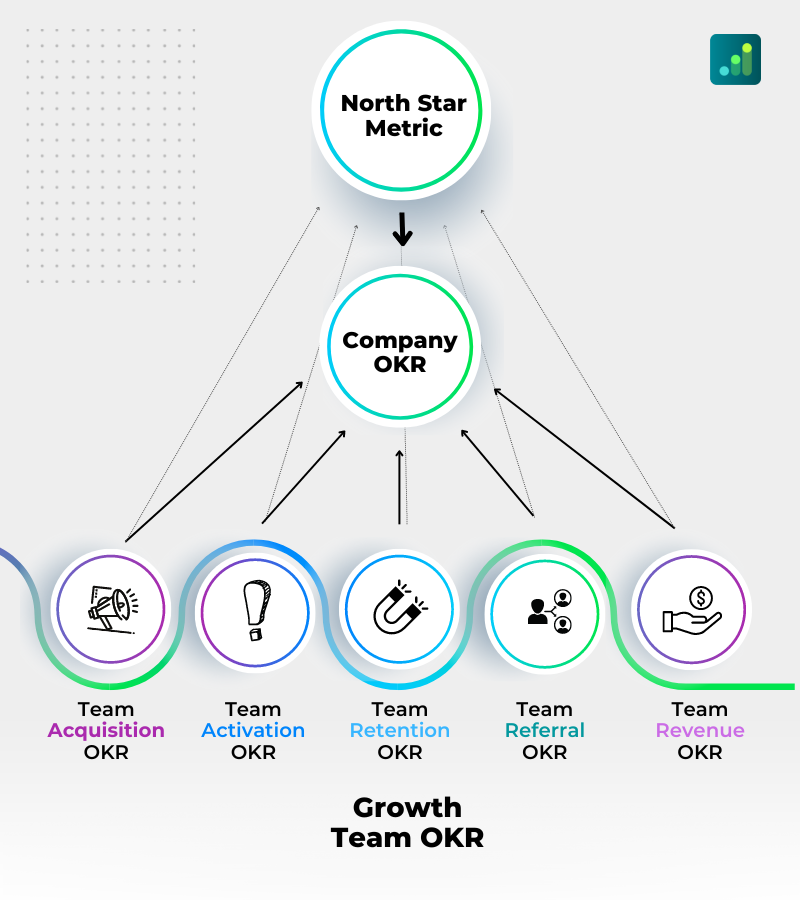
Enough with the alphabet soup, it’s that time of the year when companies are projecting goals, planning strategies, and aligning teams toward a unique mission for the next year. But, how can one combine something apparently uncertain like growth KPIs with the precision demanded by performance management methodologies, such as OKRs?
Let’s start by setting the stage:
Company OKRs: OKRs (Objectives and Key Results) is a management framework designed to encourage companies to set, communicate and monitor organizational performance. It’s a framework used by organizations worldwide to set clear and measurable goals for their teams, broken down to the department level, which is then broken down to the individual level. The end result is a measurable roadmap where everyone in the company knows their personal contribution to the end target.
Growth KPIs: the metrics shared by c-level and growth teams start with the NorthStar Metric, which is then broken down into Objectives and Success Metrics, which inspire and guide the execution of ideas, hypotheses, and experiments. The end result is a clear roadmap of the opportunities the growth team will be focusing on, as well as how to measure success in a way that is aligned with the company’s OKR.
The problem starts when we realize that OKRs are usually built based on historical data and performance averages of output metrics — those numbers that tell a story of what’s in the past. For example, the acquisition teams might know that for every ad dollar spent, they get .5 visitors to the website, which is then converted into .25 leads, which is then converted into .1 sales calls, which is then converted into .01 customers. Since this has been true for the past two quarters, the sales leaders are confident when building their plans based on past results.
Common issues with the Growth team’s OKRs:
- The growth KPIs might not have historical data to be built upon.
- Growth KPIs are usually changing. If the biggest opportunity right now is in acquisition, that’s the KPI of importance now. If the biggest opportunity is in retention, that’s the KPI of importance now.
- Growth KPIs are not output-based metrics, they are input-based. These are numbers that indicate the future — for example, the actions your users are taking that are good indicators of success to drive forward your output metrics.
In opposition to that, growth is usually challenging the assumptions around historical data and the future forecast. What if we are able to improve the effectiveness of our ad dollars from .5 to .9, how would that affect the end result of our pipeline?
While it is possible to connect the growth strategy and most performance methodologies, many have a hard time setting up both in harmony. So, how can you do this?
- Company NorthStar Metric -> Company Objective and Key Result
These metrics are not mutually exclusive, they are complementary. While the North Star Metric and following objectives should guide the operation and future market impact, allowing for fast experimentation and quick decision-making, the OKRs will serve as a common representation of said impact, translated to business metrics and results…
OKRs are set by the company’s internal point-of-view, translated by how the market perceives success from that specific business, with metrics like revenue, customer base size, or profit.
Growth metrics take the customer’s point of view and measure the increase in usage and value delivered. These metrics tend to be less standard and more connected to the specific value proposition of the business, and we can see representations of customer actions that translate the exact moment of value delivered, like the number of messages sent, time spent watching, weekly active accounts, and more.
As we can see, Growth KPIs and OKRs can be both great measurement systems to express how healthy your business is, and they are complementary in the sense that you are looking from a founder/investor/board point of view, as well as a customer perspective.
A growth team may take many different forms, and the scope of its actions can be hugely amplified when rightfully applied. So, it is important to define the nature of your growth team before deciding how to incorporate it into your company’s strategic plan. To simplify, let’s break it down into two buckets:
> Optimization: in this case, your growth team will be focusing on initiatives that are already part of your operation and mostly trying to improve its performance.
Ex: Conversion rate optimization of a landing page. New paid campaigns for performance marketing on paid channels. A different cadence for your outbound machine. Improving the adoption of an existing feature.
> Validation: in this case, your growth team will be focusing on projects that have never been done before, they are not part of your operation and you are not quite sure how they will play out.
Ex: A new acquisition channel that’s not part of your current strategy. A new product tier for a different market. The launch of a new feature.
- Success is not a validated hypothesis
Success is the achievement of an end goal, the reach of your target metric. Hypothesis, tests, and experiments are means to an end. Once one of your tests works, you should amplify it to a bigger scale, until you reach a point where you can confidently (and statistically) affirm this is how things would work.
Where does your team need to get = Objective and Key Result
How will your team get there = Tests, Ideas, Experiments, Hypothesis
The most successful teams are the ones failing the most. This means they might run an experiment that didn’t work, and most of the time, they find which experiments worked and made them reach the target.
How to connect the methodologies
1. Build a North Star Metric: identify the moment your customers get the result they came in for. For AirBnB it can be when a traveler books a ***** in one of the places listed in their marketplace (same moment for homeowners)…
2. Based on the company’s strategy, build the main OKR around the North Star Metric and pull the goals of all individuals and teams to set the main KPIs (3 to 5 are more than enough, according to the OKR methodology). That way, all team’s efforts are aligned with the question: “how do we impact the creation of value for the end-user?”. After that, all other OKRs can be based on a three-layer cadence of KPIs connected to the growth strategy. Remember not to put all eggs in the same basket and measure success by one single test.
3. Assuming your target is 70% of the OKRs, then…
Optimization-oriented growth teams can be the additional 30% that gets you the extra mile. So their metrics are incorporated into other departments’ OKRs.
Validation-oriented growth teams should be separated from the rest, having their own OKR. They have a higher failure rate and you shouldn’t be planning OKR for operational excellence based on hypothesis but on certainty.
Either way, combining the efforts of the growth strategy with the discipline and clarity provided by a performance methodology like OKRs and others can transform the focus and impact of the whole company, creating the much-needed customer-centricity business all over the globe that are hoping to acquire for their next year strategies.
This piece was produced in collaboration with Emília Chagas!



